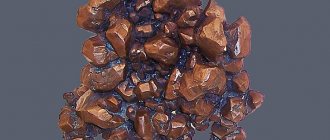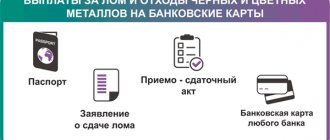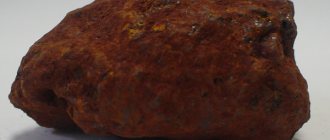Copper is among the top most common elements and is in twenty-sixth place. Usually it is found in the natural environment in the form of separately located pure nuggets, but recently such finds are becoming less and less common. Accordingly, such deposits make up only a minimal share in metal production.
The bulk of copper is mined from rocks in which it is found, often in combination with other metals. There are a large number of copper minerals. But in the metallurgical industry the most valuable types are:
- copper pyrite;
- malachite;
- chalcopyrite;
- azurite
The Russian Federation is one of the five world leaders - countries in which copper mining accounts for the largest share and brings the most fruitful results. Often copper, which is not located too deep relative to the surface of the earth, is mined by opencast mining. For this purpose, huge quarries or cuts are dug. These open copper mining sites can be several kilometers wide. The depths of the quarries can extend for more than one hundred meters. In this way, about two-thirds of all copper produced is mined. But in cases where copper deposits are deep underground, special structures are built that are designed to extract the element under the layers of the earth. They are called mines. In Russia, copper is mined using both the first and second methods.
Copper as an element
Copper is the twenty-ninth element of the periodic table, which can be found both in its native derivative and in the composition of natural minerals. These include copper pyrite or chalcopyrite, copper luster or chalcocite, and malachite.
This element appears in the form of metal, the shade of which is red. If you break the copper, you can see that the color inside is pink. It is very malleable and viscous. Due to its properties, copper is an excellent conductor of current and according to this criterion it is second only to silver, coming in second place.
Copper also conducts heat well. Such properties make the element indispensable for the electrical industry - it is used mainly in its pure form. More than fifty percent of all copper mined on the territory of the Russian Federation is consumed for the needs of this type of industry.
If we talk about the properties of copper as a chemical element of the periodic table, then it interacts little with other elements. If copper is exposed to open air, its surface becomes greenish, which is explained by the appearance of its basic carbonate, which creates a green film on the top layer of copper.
Copper salts are widely used in households. Since they are poisonous, they are used for pest control. They are also actively used as fertilizers and catalysts. Copper alloys such as brass, bronze and cupronickel are also used no less.
In the form of ore, copper, as a rule, is located in the “company” of several more, or one, metals. Very often this is gold, silver, as well as platinum, nickel or lead and bismuth. A large amount of copper is mined from a mineral such as bornite, the second name of which is mottled ore.
LO LoveOpium
Most popular
Reptiles of the Lower Volga region
Apollo 15 on the Moon 50 years ago
Secrets of Kubachany masters
2021 Audubon Photography Awards Bird Competition
latest comments
- Igor on Apollo 15 on the Moon 50 years ago No images open.
- Barkat on Houses of unusual architecture Wonderful architecture.
- 123 on Catastrophic flooding in Western Europe 2022 you are fine. with the head
Structure of the Russian raw material base of copper
Unlike all countries in the world, forty percent of the Russian raw material base consists of copper-nickel sulfide deposits. And nineteen percent are pyrite deposits.
And this gives Russia an advantage over other countries, since their main reserves are located in porphyry copper deposits. The Krasnoyarsk ore region is rich in copper and nickel deposits. There are mainly sulfide deposits here.
The main part of all copper deposits in the Russian expanses is located in the Urals and in the Trans-Baikal Territory. In total, more than forty percent of the total volume of all copper owned by the country is mined there.
The Orenburg and Chelyabinsk regions have the greatest potential for increasing copper production. The Trans-Baikal region is rich in geological and industrial copper deposits in cuprous sandstones.
The Kemerovo region, Buryatia, Altai Territory and the North Caucasus are rich in copper pyrite ore deposits. At the moment, the main share of mined copper comes from the Udokan deposit. Currently it is the largest deposit in the Russian Federation.
Several new copper deposits have been discovered in the Far East and the Urals, which belong to the porphyritic copper type.
Main copper deposits
| Subsoil user, field | Geological-industrial type | Reserves, thousand tons of WO3 | Share in balance reserves of the Russian Federation, % | WO3 content in ores, % | Production in 2012, t WO3 | |
| A+B+C1 | C2 | |||||
| OJSC MMC Norilsk Nickel | ||||||
| Oktyabrskoe (Krasnoyarsk region) | Sulfide copper-nickel | 14631 | 5723 | 22,3 | 1,65 | 351 |
| Talnakhskoe (Krasnoyarsk region) | Sulfide copper-nickel | 7877,2 | 2728,2 | 11,6 | 1,11 | 80,6 |
| Norilsk I (Krasnoyarsk region) | Sulfide copper-nickel | 773,1 | 836,1 | 1,8 | 0,48 | 13,9 |
| OJSC "Kola MMC" | ||||||
| Zhdanovskoe (Murmansk region) | Sulfide copper-nickel | 765,6 | 227,2 | 1,1 | 0,3 | 12,2 |
| OJSC "Gaisky GOK" | ||||||
| Gayskoye (Orenburg region) | Copper pyrite | 4555,6 | 478,5 | 5,5 | 1,3 | 62,5 |
| LLC "Bashkir copper" | ||||||
| Yubileiny (Republic of Bashkortostan) | Copper pyrite | 1360,2 | 46 | 1,5 | 1,7 | 36,2 |
| Podolsk (Republic of Bashkortostan) | Copper pyrite | 1701,3 | 16,7 | 1,9 | 2,11 | 0 |
| LLC "Baikal Mining Company" | ||||||
| Udokanskoye (Trans-Baikal Territory) | Cuprous sandstones | 14434,6 | 5519,6 | 21,8 | 1,56 | 0 |
| LLC "GDK Baimskaya" | ||||||
| Gerbil (Chukchi Autonomous Okrug) | Porphyry copper | 2606,2 | 1124,5 | 4 | 0,83 | 0 |
| LLC "GRK Bystrinskoe" | ||||||
| Bystrinskoye (Trans-Baikal Territory) | Skarn copper-magnetite | 1717,5 | 355,9 | 2,3 | 0,78 | 0 |
| CJSC "Mikheevsky GOK" | ||||||
| Mikheevskoe (Chelyabinsk region) | Porphyry copper | 1264,3 | 299,7 | 1,7 | 0,44 | 1,4 |
| CJSC "Tominsky GOK" | ||||||
| Tominskoe (Chelyabinsk region) | Porphyry copper | 743,3 | 793,2 | 1,7 | 0,47 | 0 |
| OJSC "Svyatogor" | ||||||
| Volkovskoe (Sverdlovsk region) | Vanadium-iron-copper | 1612,2 | 153,4 | 1,9 | 0,64 | 6,6 |
Copper Ural
The largest copper deposits relative to the entire Russian territory are located in the Urals. In order to simplify the extraction of the copper element from those ores in which its presence is very small. This method is called hydrometallurgical. It is also used in cases where it is necessary to extract copper from what is waste from other metallurgical industries.
The basis of the hydrometallurgical method is the conversion of complexly soluble compounds of the required element into simpler ones that dissolve more easily. Next comes the process of extracting them from the resulting solution. This procedure is carried out using several methods, but the most common of them are:
- solution leaching;
- use of ion exchange resins;
- electrolysis.
Udokan copper deposit
This deposit is located in the Trans-Baikal Territory on a ridge called “Udokan”. This area is seismically dangerous and is located in the permafrost zone. Udokan is the largest copper deposit in Russia. It plays an important role in the extraction of this element throughout the world, being at the third stage. The ores found in this mine consist almost entirely of copper and have only a small amount of silver in their composition.
The discovery of the Udokan deposit occurred in the last century, or more precisely in 1949. The First Main Directorate of the USSR Ministry of Geology sent a forestry expedition to Udokan, which made the first discovery. Over the next six years, a detailed study of this deposit took place and big plans were made for its development. But unexpectedly, after another year, all work was completely frozen.
After another ten years, they again became actively interested in the deposit, took many different samples, and carried out a huge number of other studies, but then again all work was completely unexpectedly stopped. It was only in 2008 that the deposit began to be actively developed. Its development takes place in an open-pit manner - copper is extracted from a quarry. At the moment, the copper deposits in this deposit are large-scale and more than thirty thousand tons of ore are mined from here every year.
The raw materials are mine
“The Russian Copper Company has adopted a raw materials development program for deposits, designed until 2050, both for existing facilities and taking into account promising areas and ore occurrences,” says Vsevolod Levin, President of the Russian Copper Company.
According to the company, investments in mining in 2022 will amount to about $760 million. The growth of investments in the mining division of RMK compared to 2022 is 13%, excluding investments in the acquisition of the Malmyzhskoye deposit in the Khabarovsk Territory. The main investment projects of RMK this year, along with the Malmyzh project in Russia, were the construction of the Tominsky mining and processing plant, as well as the development of the Aralchinsky section of the Vesenne-Aralchinsky deposit and the Kundyzdy deposit in Kazakhstan.
Sorsk copper-molybdenum deposit
This source is located at the intersection of two tectonic zones - northwestern and northeastern, near the Batenevsky Ridge. The main minerals that include copper and are mined here are molybdenite, chalcopyrite, and pyrite.
This deposit was formed due to the fact that high-temperature processes regularly occurred in this area. It is divided into several components - Western and Eastern, which in turn are separated from each other by a barren gap.
This field is also being developed by open-pit mining, and its parts - Eastern and Western - are developed to varying degrees. The second has been mastered almost twice as much as the first.
The ore here is enriched by several processes. This procedure occurs in several methods:
- in cone-shaped crushers, minerals are crushed four times;
- wet grinding using specially equipped mills, as well as classifiers made in a spiral shape;
- flotation, divided into two stages - selective and collective;
- finishing of copper and molybdenum concentrate;
- dehydration;
- drying;
- blending.
The operation of the processing plant is dependent on recycled water supply.
Content:
The Russian metallurgical complex is a vast industry that includes enterprises that smelt ferrous and non-ferrous metals.
The latter occupies a very important place in the economy of our country. Today we have several centers of non-ferrous metallurgy, which extract and enrich non-ferrous ores, rare and precious metals. Non-ferrous metallurgy deals with several types of metals - these are basic or so-called heavy. These include copper, light, small, alloying, noble, rare and scattered.
Let's take a closer look at copper production. Copper production centers are concentrated in different regions of our country. The location of such enterprises is determined by a number of factors, among which it should be noted:
- raw materials;
- energy and fuel factor;
- consumers.
Sibay copper-zinc-pyrite deposit
This deposit is not only copper, but also zinc and pyrite. It is located near the city of Sibay, which is located in Bashkortostan. The discovery of this deposit occurred in 1913, but they began to develop it only two decades later.
From west to east, the Sibay copper-zinc-pyrite deposit is limited by faults. Here ores are mined exclusively using the closed method. At the beginning of the twentieth century, a mine was built on the deposit. Its depth exceeds four tens of meters.
Later, in 2004, a branch was formed on the site of the Sibay deposit, which is called “Uchalinsky GOK”.
Mineral extraction methods
In Russia there are deposits such as shale and sandstone. Copper pyrite, copper-nickel and porphyry copper forms occur here. The mining industry uses various methods to extract minerals from the depths of the earth.
Depending on the depth of occurrence, ore is mined using open or closed methods. There are standards that determine the feasibility of the depth of excavation of soil layers and the use of technologies that reduce their costs.
The work technology includes the following:
- use of self-propelled equipment;
- production of ore extraction directly;
- filling the resulting voids with materials to make further work safe.
With the open method, fossils are selected in layers, this ensures their fullest use. For deep quarries, the technology of cyclic-flow operations is suitable, it depends on the characteristics of the layers.
Negative consequences of mining
When the formations occur at a depth of 500 to 1000 m and deeper, the closed method of copper mining is convenient. This requires vibration mechanisms; the rock is completely excavated and delivered to the surface. The voids formed underground are filled using pipes lined with rubber or basalt resin.
It is economically advantageous to locate the mineral processing industry in close proximity to the places of their extraction. It is also necessary to build plants for recycling waste after processing. This can promote the release of various beneficial products. For example, processing sulfur dioxide makes it possible to obtain useful fertilizers containing sulfur.
The main problems of the copper mining industry
Today, one of the main problems of the copper mining industry is its containment. It is due to the fact that the land is gradually becoming poorer, resources are being depleted and it is becoming more and more difficult to extract ore.
The depleting resource base leads to the fact that many enterprises engaged in activities related to the extraction of copper ore are faced with major financial difficulties and not every company manages to get through them and return to the previous rhythm of work.
But the most serious problem associated with the mining of copper ore is severe environmental pollution. Due to the fact that so-called dumps are formed around the formed quarries, this leads to the fact that after ore mining, heavy metals from them fall into the layers of the earth with each rain, from where they are transferred by groundwater flows to rivers and lakes. Lately there has been talk about turning these embankments into second-rate raw materials, which can be used in other production and slightly solve the problem of environmental pollution.
Power reserve
“The extraction of copper raw materials, one of the determining parameters of the supply of metal on the market, is showing a downward trend. According to preliminary estimates, global production in 2022 will decrease by 0.8% to 20.7 million tons,” says Airat Khalikov, director of the Center for Economic Forecasting at Gazprombank. However, according to him, the total volume of refined copper smelting in the world will not change in 2019 and will amount to 23.6 million tons: “The reduction in raw material production is compensated by the consumption of concentrate stocks. The growth rate of copper raw material production and copper smelting in 2022 - 2024 will be at the level of 1.6% per year.”
Analysts attribute the decline largely to the lack of investment in production in 2014–2022. One of the deterrents to investment is the tightening of environmental requirements on the part of states, which lead to an increase in production costs. Therefore, the shortage of raw materials remains one of the most important challenges for the global copper industry.
In this regard, elements of the strategies of Russian holdings related to solving the problems of increasing the raw material base appear justified. And this year, many were able to advance in the implementation of these programs.
The largest copper mining enterprise in Russia
Recently, the largest copper mining enterprise in Russia was launched in the Chelyabinsk region - the Mikheevsky Mining and Processing Plant. It is the largest mining project developed in the state since the collapse of the Soviet Union.
The Mikheevskoye deposit was included in the list of the fifty largest copper deposits in the world. Its main feature is the low metal content in the mined ore, but its significant reserves. It is planned to extract more than eighteen tons of ore from this deposit annually, and over time to increase the extracted volumes several times.
A huge amount of money was invested in this project, amounting to twenty-five billion rubles. The opening of this enterprise contributed to the creation of seven hundred new jobs. The personnel of the Mikheevsky Mining and Processing Plant includes metallurgists-concentrators, as well as miners. Residents of nearby areas work here. In total, the company's staff numbers about one thousand people.
The management plans to equip the enterprise with a 100% water circulation system, which will be closed. The equipment located at the enterprise and all its systems will be equipped with the latest technology. Dust collection and dust suppression systems will be installed here, which will facilitate the most difficult work of the Mikheevsky GOK employees.
Performance parity
In order to balance mining and metallurgical capacities, RMK has launched an investment project that will increase the productivity of the metallurgical division for copper cathode by 40% to 310 thousand tons per year.
To achieve this, the company plans to increase the productivity of the copper smelter by approximately 40% to 230 thousand tons of blister copper from mineral raw materials per year and organize on its site a new section for smelting copper anodes with a capacity of 265 thousand tons. To process such volumes, the Kyshtym Copper Electrolyte Plant is constructing a new electrolysis workshop, which will allow the enterprise to produce 64% more cathodes - 230 thousand tons per year. The projects are due to be completed in 2022.
Together with the increase in capacity, this will improve the efficiency of the existing technological chain for the production of cathode copper at and at the Kyshtym Copper Electrolyte Plant (KMEZ) by eliminating the fire refining operation of blister copper to produce copper anodes. It is currently being performed in Kyshtym. Instead of blister copper ingots, copper anodes will be sent from Karabash to Kyshtym for subsequent electrolytic refining and production of cathode copper. Thanks to this, the production load on the environment will also be reduced.
Efficiency and environmental safety have become a hallmark of all RMK investment projects. One of the most obvious examples is the modernization of a copper smelter.











